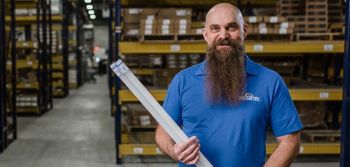When Lamps Need replaced, Don't Leave Waste: What is hazardous about lighting and how to properly dispose of your lighting
- June 7, 2022
- Best Practices
- Lighting

You may think of hazardous wastes as the radioactive materials or toxic sludge you see in disaster movies, but we are actually surrounded by hazardous wastes every day. Before you worry too much, you are probably safe, but many of the light bulbs we live and work around contain chemicals and substances that are harmful if we are exposed to them. Therefore, it is important to understand what devices contain hazardous wastes, who is responsible for their disposal and how you should dispose of them.
What is hazardous about lighting?
While intact, fluorescent and High-Intensity Discharge (HID) lamps do us no harm and are considered general waste. Alas, light bulbs break easily. Once a lamp is broken, the mercury and phosphors being released from it makes it hazardous waste because those elements are toxic for humans. Ballasts can also be harmful, as they have varnish and other chemicals to seal copper windings. Even being around a container full of broken lamps and ballasts can be dangerous. If you disturb the contents inside, you could be breathing in mercury dust and other phosphors.
LED lamps and fixtures do not contain lead, mercury or phosphors and are not considered hazardous waste. LED components are electronic like a television or computer. Still, the electronic components like circuit boards and diodes will not break down in a landfill and should be recycled.
What regulations must be followed?
Once you get rid of your used lamps and ballasts, they are no longer your problem, right? Well, not quite. It is important to understand that you own your waste forever. This means throwing used lamps in the dumpster is not an option. The law requires you to have a proper chain of custody with documentation that proves your hazardous waste has been disposed of responsibly. Even if someone not associated with your company takes your hazardous waste and disposes of it incorrectly, the liability falls on you. You might think it is expensive to properly dispose lamps, but the cost of fines, sanitizing your entire facility and lawsuits from employees exposed to harmful chemicals is astronomically higher.
How do you know what elements you are at risk of being exposed to? If you use or stock certain lamps, you are required by law to have Material Safety Data Sheets (MSDS) on hand. That way, if an incident occurs, emergency medical personnel will know exactly what a person might have been exposed to. If your facility does not have the required MSDS on file, Van Meter can help collect them.
How should materials be properly disposed?
Where should you go to get the proper chain of custody documentation? Commercial and industrial facilities should work with a thoroughly vetted disposal and recycling vendor that has proof of its capabilities, is approved by the Environmental Protection Agency and can provide the necessary documentation. Van Meter works with disposal companies and can offer a couple solutions.
If you have a project with a large number of lamps to dispose of, we can send a drum or container in which you can place the lamps in. Once it is full, the disposal company can pick it up, dispose of it and provide proper chain of custody documentation. Or, for a one-time fee, we can send you a box with a heavy-duty plastic liner to hold used materials. Once the box is full, seal it up and ship it with the supplied pre-paid shipping label. When the disposal company receives the box and disposes of the lamps, they will send you the chain of custody certification.
What happens to the disposed lamps?
Where do these hazardous wastes go once disposed? Many materials can be separated and reused. While they are harmful in some cases, mercury and lead have their uses and can be recycled and reused in other applications. The glass and copper from lamps and ballasts can be recycled. Even LED circuit boards can be ground up, melted and reused in other applications. Most of these components are not biodegradable and contain some level of chemicals and phosphors, so recycling and repurposing them minimizes the risk of contaminating any air, food or water supplies.
It is important to know the hazardous waste regulations in your state and what you are responsible for disposing of properly. If you are not sure or have questions regarding ways Van Meter can help with lighting disposal, contact us .

ARTICLE BY:
CHARLES DIX
EMPLOYEE-OWNER, LIGHTING SUPERVISOR